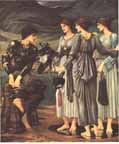 Perseus stares critically at the sea nymphs. His unwavering gaze indicates his weariness of these creatures; he wants to know what they want of him and if they intend to inflict harm. Identical in appearance, the sea nymphs engage with Perseus and hand him pieces of this armor. Perseus knows that they are trying to help, but painful memories rush to his head. While his fragile heart aches for a more intimate exchange the sea nymphs, the disillusioned Perseus keeps his distance from one of life's most puzzling enigmas: women.
Perseus stares critically at the sea nymphs. His unwavering gaze indicates his weariness of these creatures; he wants to know what they want of him and if they intend to inflict harm. Identical in appearance, the sea nymphs engage with Perseus and hand him pieces of this armor. Perseus knows that they are trying to help, but painful memories rush to his head. While his fragile heart aches for a more intimate exchange the sea nymphs, the disillusioned Perseus keeps his distance from one of life's most puzzling enigmas: women.
In his Perseus and the Sea Nymphs, Burne-Jones creates a seemingly calm atmosphere. Situated in front of a dark, painterly background, Perseus and the nymphs pop out of the foreground. The rich texture of the nymphs' clothing contrasts with that of Perseus' rigid armor. The figures' peachy flesh offers a sense of comfort. Placed against a cold, unmerciful landscape, Perseus and the sea nymphs indicate the determination to survive in an often-cruel world. It seems that Burne-Jones employs these compositional juxtapositions to convey his own feelings of confusion and despair. A troubled romantic, Burne-Jones' painting translates abstract fragments of his own life into a concrete form of expression. In terms of this view of love, Burne-Jones does not commit to any extreme. Perseus and the sea nymphs acts as a document of his prevalent confusion and frustration.
Discussion Questions
1. What time of day is it? Does lighting act as a symbolic element?
2. In what ways does Burne-Jones depart from the PRB? In what ways does his technique coincide with that of the members of the Brotherhood?
3. Why does Burne-Jones depict the sea nymphs as identical?
4. Does Burne-Jones' personal connection with painting detract from the emotional impact of Perseus and the sea nymphs?
Last modified 22 October 2006